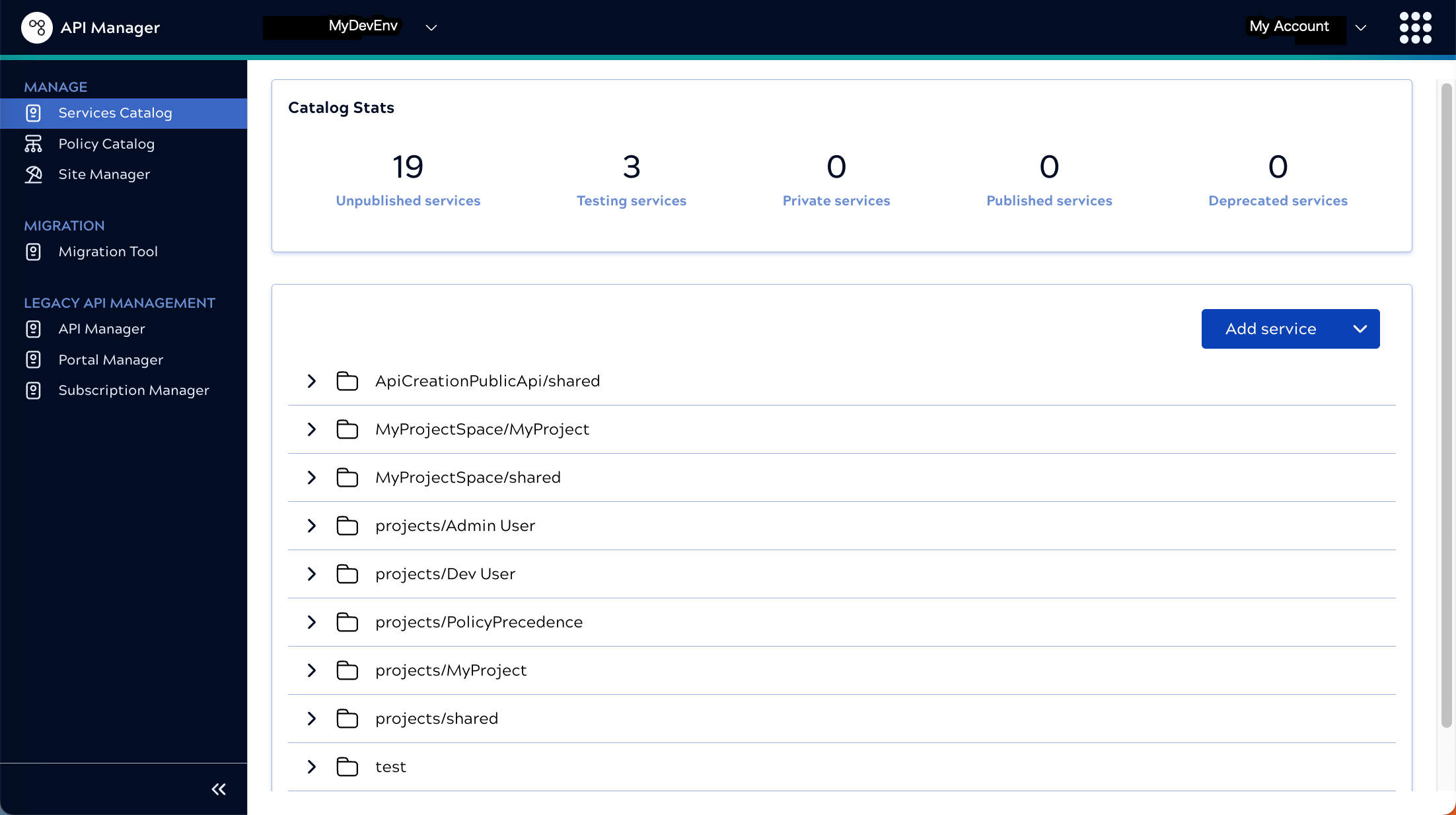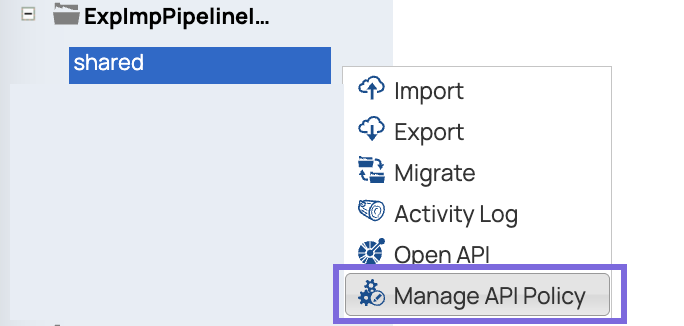Move from APIM to APIM 3.0
If your organization is moving from APIM to API Management 3.0, it will help to understand the basic conceptual differences. This topic compares terms and introduces the automated migration process.
APIM compared with API Composer
In API Management 3.0, Services are SnapLogic assets just like tasks and pipelines. This makes it easier to organize and manage them. You also define Policies independently, which makes them easier to reuse.
The following table maps APIM terms and components to APIM 3.0.
| APIM | APIM 3.0 |
|---|---|
| API Manager: Console to define and manage API Versions, Proxies, and Policies. | Services catalog and Policy catalog: List Services and Policies and provide the interface for defining Services and Policies. Existing APIM customers also have access to API Manager, Portal Manager, and a Migration tool. |
| Portal Manager: Interface for setting up and managing the Developer Portal. | Site Manager: Interface for setting up and managing DeveloperHub. |
| Developer Portal: Makes APIs and Proxies available to internal and external consumers. | DeveloperHub: Makes Services available to internal and external consumers. Admins define the look and feel with themes and customizable components. |
| API Version: A Triggered or Ultra Task endpoint with a user-applied version and Policies. | Service Version: A collection of Triggered Task, Ultra Task, or external endpoints with a user-applied version and Policies. |
| Proxy Version: Collection of one or more external endpoints. | Service: One or more endpoints, which can include references to Triggered and Ultra Tasks, or external URLs with a user-applied version and Policies. |
| Policy: Authentication/authorization, traffic management, transformation logic, and request validation applied to a specific API version or Proxy. | Policy: A collection of rules. Rules were called Policies in APIM. Policies are reusable, they can apply to all Services, individual Services, or specific Service endpoints. |
Introduction to API migration
If APIM assets exist in your environment and both APIM and the new APIM 3.0 features are enabled, the interface includes a Migration Tool and pages to access the legacy API Manager, Portal Manager, and Subscription Manager:

Migration wizard
The migration wizard guides you through three main steps:
- Select one or more API versions or Proxies to migrate.
- Migrate the associated Policies or disable the Migrate Policies toggle to use Policies from APIM 3.0 Policy Catalog after migration.
- Select the location for the migrated assets.
When you start migration of one or more assets, the migration process happens in the background and you can continue working. Notifications inform you about the status of migration for each asset. A migration that fails for some reason doesn't block other migrations.
To migrate assets, the SnapLogic Platform:
- For an API Version, creates a Service Version with the same name, description, endpoints, accounts, files, tags, and status.
- For a Proxy and its endpoints, creates a Service Version with the same name. Each Proxy endpoint and each mapping rule becomes a Service endpoint.
- Migrates Path objects that map to endpoints or tasks as HTTP methods:
- For published API Versions and Proxies, the new endpoint contains the HTTP methods defined in the specification.
- For unpublished API Versions and Proxies, the endpoint contains all of the HTTP methods defined by OAS, but with empty definitions.
- Creates Service Policies that correspond to the Proxy or API Policies. All Policies on a Proxy become rules in one Policy associated with the new Service and all of its endpoints. Proxy endpoint Policies become rules in a Policy associated with the new Service endpoint.
- Copies the assets related to the API or Proxy to the Service version and saves the Service version in the project you select.
- Resolves the references to the new location.
- Tracks migration of API versions and Proxies. After a Service created by migration is published in APIM 3.0, you can't migrate the source API or Proxy again.
A successful migration results in the addition of a Service version in the Services Catalog. No changes are made to the original API Version, Proxy, or any assets. Calls to the original URL of a migrated API Version continue to be processed by the original API Version until the new Service created by migration is published. Refer to the Migration reference page for details on how API Management 3.0 migrates specific assets.
Migration events are tracked on the Monitor Activity logs page. The event notes the destination project of the migrated resources and the user who migrated them.
Known limitations
- In API Management 3.0, the Service name must be unique in a project and the URL slug must be unique in an environment. If you try to migrate an API Version or Proxy into a location where that name already exists, the migration process appends an underscore and a number to the name.
- To protect the integrity of migrated assets, after an API or Proxy version is migrated and published in APIM 3.0 migration is locked. You can't migrate it again unless you unpublish it.
- APIM Policies created in Classic Manager from the Project menu Manage API
Policy option aren't included in migration because they aren't part of the API
version:

- Mapping expressions are migrated as is. You should check to make sure that they make sense in the
context of the new Service. For example, an expression that relies on
uri.pathsegment[1]might not behave as expected. - Due to the difference between Services and legacy Proxies, migration of a Proxy with mapping rules that use expressions requires adjustment of the migrated asset. If you receive a 200 error with a message about conversion failure or a 400 bad request error, check and correct the expressions.
- You might have to adjust the URL that you use to call an external endpoint migrated from a Proxy.
The default behavior of API Management 3.0 is to append the end of the path to the
URL. For example, for an upstream path of
https://google.comwith a path of listlist, if a user callshttps://google.com/list/apps, the URL is updated tohttps://google.com/apps. If mapping rules append values to the upstream URL, make sure to modify the upstream URL. - Migration of an unpublished API version or Proxy results in the Service version endpoint(s) supporting all HTTP methods, with empty definitions.
- Migration of a published Proxy with mapping rules doesn't use the specification and results in empty endpoints.


